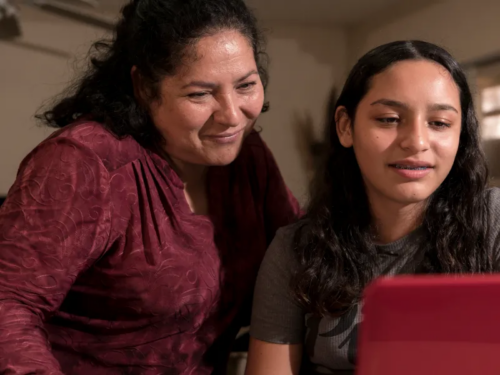
Table of Contents
What is Eldest Daughter Syndrome?

Written By: Ashley Laderer

Clinically Reviewed By: Dr. Don Gasparini
Updated: July 18, 2024
5 min.
While not a formal diagnosis, "eldest daughter syndrome" is a commonly experienced phenomenon that highlights the unique challenges oldest daughters face.
Learn more about our Clinical Review Process
Table of Contents
The oldest daughter in a family often experiences a unique set of challenges and responsibilities that can shape her personality and impact her mental health. This phenomenon, known as “eldest daughter syndrome,” resonates with many daughters, offering validation and awareness of their circumstances. Despite not being a formal diagnosis, it has gained significant attention on platforms like TikTok, fostering community and understanding among those affected.
Whether you’re an oldest daughter seeking recognition or a family member wanting to understand more, here’s what you should know about eldest daughter syndrome.
What is eldest daughter syndrome?
“Eldest daughter syndrome is a term used to describe the unique challenges and expectations that are often placed upon the oldest child in a family,” says licensed clinical professional counselor Jamila Jones. “As the firstborn daughter, these children are often expected to set an example for their younger siblings, taking on more responsibilities and acting as role models.”
Introduced in the early 1900s by an Austrian psychotherapist, Alfred Adler, this concept is linked to birth order theory, which suggests that a child’s position in the family affects their personality and life experiences. As a result, “oldest children have more responsibilities and ‘neuroses’ compared to their other siblings.”
While being a role model can foster leadership and independence, it can also impose pressure and a pursuit of perfection. Kasey Scharnett King, a licensed marriage and family therapist, notes that in some families, “The oldest child may function more as a caretaker or even a surrogate parent to their sibling, missing out on typical childhood experiences.” King observes, “In dual-parent households, the oldest child might become a third adult, intimately aware of their parents’ personal matters and often a mediator in their disputes.”
It’s essential to recognize that not every eldest daughter will experience these family dynamic challenges or develop this syndrome. Family dynamics and individual upbringing vary widely, shaping each person’s unique experience.

Everyone deserves accessible therapy — including oldest daughters
Virtual intensive therapy programs with other people who get it.
Signs of eldest daughter syndrome
Eldest daughter syndrome encompasses a range of behaviors and feelings stemming from the unique pressures and responsibilities often placed on the firstborn daughter in a family. Jones and King say signs that may indicate someone is experiencing eldest daughter syndrome include:
- Having a strong sense of responsibility
- Feeling a need for control
- Carrying the heavy weight of parents’ expectations
- Perfectionism
- Struggling with same-age relationships
- Feeling resentment towards family (parents or siblings)
- Always putting others before themselves
- People pleasing behaviors
- Anxiety
- Depression

10 Symptoms of Daughters of Narcissistic Mothers
Charlie Health Editorial Team
Eldest daughter syndrome vs eldest daughter trauma
The traits and behaviors mentioned above all be signs of eldest daughter syndrome, but for some oldest female siblings, the heavy burdens and expectations placed on them can lead to long-term emotional and mental health issues — known as eldest daughter trauma. Someone dealing with eldest daughter trauma is facing the lasting implications of these pressures, and many also struggle with depression, anxiety, and other mental health conditions. Other symptoms of eldest daughter trauma might include guilt, burnout, low-self esteem, and more. By contrast, eldest daughter syndrome recognizes the challenges faced by some oldest female siblings but doesn’t necessarily imply trauma or long-term psychological harm.
How do you heal from eldest daughter syndrome?
No matter how old you are, it’s never too late to make healthy changes in your life to cope with the mental health effects of being the oldest daughter. Here are five ways to improve your well-being.
1. Learn to prioritize yourself
When you grow up taking care of other people before taking care of yourself, it can be challenging to think about putting yourself before others. However, it’s important to remember the saying that you can’t pour from an empty cup. You need to care for yourself before caring for others.
“Make yourself a priority,” King says. “As a ‘parental’ figure, you have become a natural nurturer and caregiver, and you were never taught how to take care of yourself. Spending time alone is a great way to focus solely on you.”
2. Practice self-care
One way to prioritize yourself is to revamp your self-care routine or establish one for the first time. Jones says making time for yourself and your needs can help reduce and prevent burnout and stress. Examples of self-care include exercising regularly, journaling, or practicing mindfulness.
3. Lean on your support system
While you’re used to others relying on you, it’s important to remember that you also deserve help. “It’s important to have a support system of friends or family you can confide in and lean on,” says Jones. Identify adult relationships in your life who can support you when needed. Having the proper social support is crucial for your mental health.
4. Learn to set boundaries
As the oldest daughter, you might have become a people pleaser, always saying “yes” when someone needs help. However, it’s important to prioritize yourself and set healthy boundaries. “Saying ‘no’ to someone else is saying ‘yes’ to you,” says King.
King suggests the following ideas for boundary setting:
- Don’t be always available to others
- Avoid answering your phone after a specific time in the evening
- Limit time spent on the phone with draining people
- Remember that you don’t always need to have answers or give advice
- Preserve your energy and encourage others to find support beyond you
- Inform your loved ones of your boundaries and the consequences of violating them
5. Know when to seek help
Eldest daughter syndrome can lead to anxiety and depression, according to Jones. If mental health issues are affecting your daily life or work/school performance, seeking help from a mental health professional is advisable. Therapy can teach healthy self-talk, interpersonal skills, and setting boundaries to improve well-being. It can also help break generational trauma by providing a safe space to explore and heal from past family dynamics and inherited behaviors, fostering healthier adult relationships and coping mechanisms for future generations.

How Charlie Health can help
If you or a loved one are struggling with mental health, Charlie Health is here to help. Charlie Health’s virtual Intensive Outpatient Program (IOP) provides more than once-weekly mental health treatment for people and families dealing with serious mental health conditions. Our expert clinicians incorporate evidence-based therapies into individual counseling, family therapy, and group sessions. With this kind of holistic online therapy, managing your mental health is possible. Fill out the form below or give us a call to start healing today.





